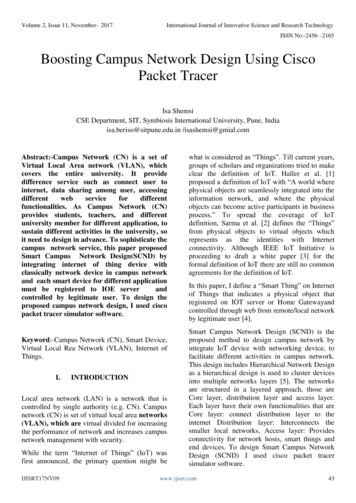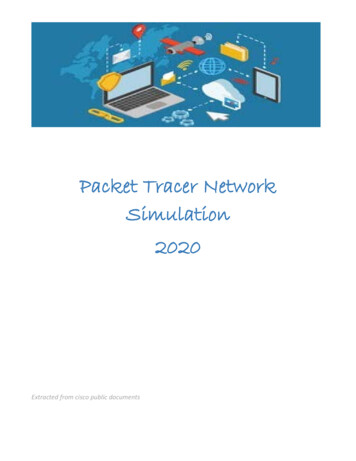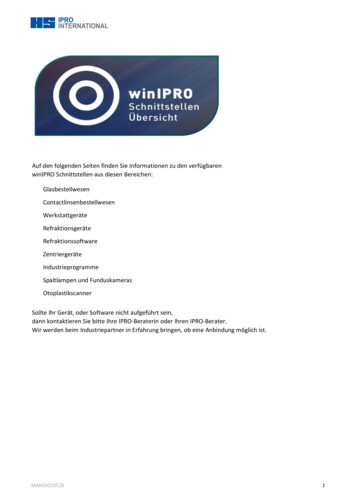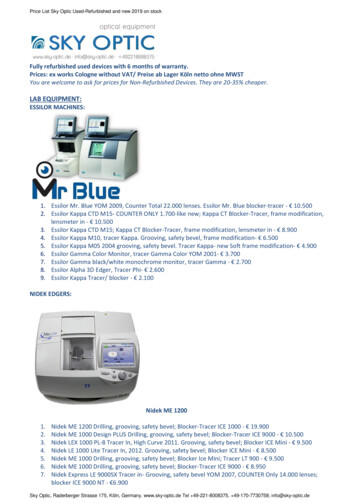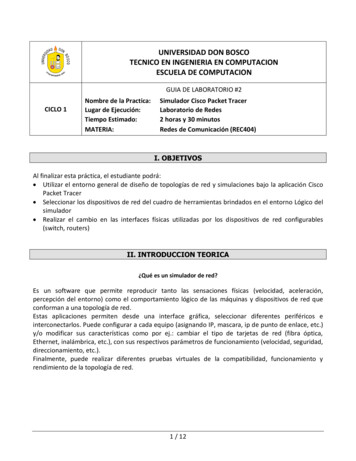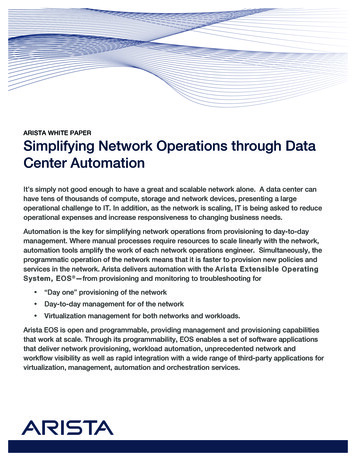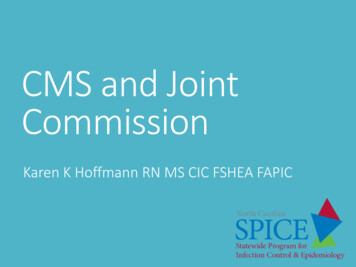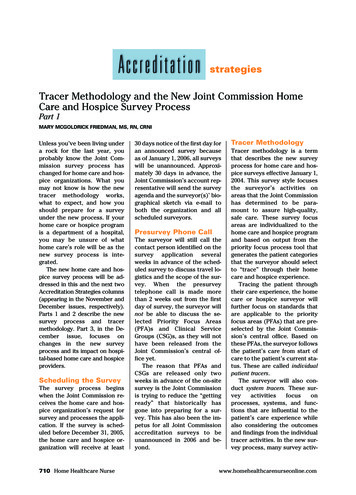
Transcription
Tracer Methodology and the New Joint Commission HomeCare and Hospice Survey ProcessPart 1MARY MCGOLDRICK FRIEDMAN, MS, RN, CRNIUnless you’ve been living undera rock for the last year, youprobably know the Joint Commission survey process haschanged for home care and hospice organizations. What youmay not know is how the newtracer methodology works,what to expect, and how youshould prepare for a surveyunder the new process. If yourhome care or hospice programis a department of a hospital,you may be unsure of whathome care’s role will be as thenew survey process is integrated.The new home care and hospice survey process will be addressed in this and the next twoAccreditation Strategies columns(appearing in the November andDecember issues, respectively).Parts 1 and 2 describe the newsurvey process and tracermethodology. Part 3, in the December issue, focuses onchanges in the new surveyprocess and its impact on hospital-based home care and hospiceproviders.Scheduling the SurveyThe survey process beginswhen the Joint Commission receives the home care and hospice organization’s request forsurvey and processes the application. If the survey is scheduled before December 31, 2005,the home care and hospice organization will receive at least710 Home Healthcare Nurse30 days notice of the first day foran announced survey becauseas of January 1, 2006, all surveyswill be unannounced. Approximately 30 days in advance, theJoint Commission’s account representative will send the surveyagenda and the surveyor(s)’ biographical sketch via e-mail toboth the organization and allscheduled surveyors.Presurvey Phone CallThe surveyor will still call thecontact person identified on thesurvey application severalweeks in advance of the scheduled survey to discuss travel logistics and the scope of the survey. When the presurveytelephone call is made morethan 2 weeks out from the firstday of survey, the surveyor willnot be able to discuss the selected Priority Focus Areas(PFA)s and Clinical ServiceGroups (CSG)s, as they will nothave been released from theJoint Commission’s central office yet.The reason that PFAs andCSGs are released only twoweeks in advance of the on-sitesurvey is the Joint Commissionis trying to reduce the “gettingready” that historically hasgone into preparing for a survey. This has also been the impetus for all Joint Commissionaccreditation surveys to beunannounced in 2006 and beyond.Tracer MethodologyTracer methodology is a termthat describes the new surveyprocess for home care and hospice surveys effective January 1,2004. This survey style focusesthe surveyor’s activities onareas that the Joint Commissionhas determined to be paramount to assure high-quality,safe care. These survey focusareas are individualized to thehome care and hospice programand based on output from thepriority focus process tool thatgenerates the patient categoriesthat the surveyor should selectto “trace” through their homecare and hospice experience.Tracing the patient throughtheir care experience, the homecare or hospice surveyor willfurther focus on standards thatare applicable to the priorityfocus areas (PFAs) that are preselected by the Joint Commission’s central office. Based onthese PFAs, the surveyor followsthe patient’s care from start ofcare to the patient’s current status. These are called individualpatient tracers.The surveyor will also conduct system tracers. These surveyactivitiesfocusonprocesses, systems, and functions that are influential to thepatient’s care experience whilealso considering the outcomesand findings from the individualtracer activities. In the new survey process, many survey activ-www.homehealthcarenurseonline.com
ities are the same (staff andfamily interviews, home visits);however, the specific activitiesand processes that comprisethe tracer methodology andnew survey process are different than the activities andprocesses of prior years.Priority Focus ProcessToolBoth the organization and thesurveyor will receive the CSGsand PFAs electronically 2 weeksprior to the survey. Organization information is gathered andanalyzed electronically using aset of defined automated rulesor algorithms to produce theCSG and PFA outputs. For homecare and hospice organizations,the following information is inputted into the Joint Commission’s electronic priority focusprocess tool: Previous Joint Commissionsurvey findings, complaint and sentinel eventinformation that the JointCommission is aware of, application for survey information, and if the organization is aMedicare-certified homehealth agency, data generated from Home Health CareCompare.Home Care and HospicePriority Focus AreasIf you were ever fortunateenough to have won the equivalent of the Joint Commissionlottery and were selected to undergo a random unannouncedsurvey (RUS), you’ll recall thatfive grid elements were preselected for the surveyor to focusactivities on during the 1-daysurvey. The concepts of focusing on a specific set of standards or PFAs are similar tovol. 22 no. 10 October 2004that of a RUS, except in a RUSall the grid elements were preset per calendar year and thePFAs are individualized for theorganization. Similar to the gridelements of years past, arePFAs listed in Figure 1.Two weeks prior to the onsite survey, between four andsix PFAs are selected for the surveyor(s) to focus survey activities on during the individual patient tracers and system traceractivities.PFAsaretheprocesses, systems, or structures within a home healthagency or hospice that, according to the Joint Commission, cansignificantly impact the qualityWhat if a standard, not related to a targeted PFA, isfound to be noncompliant?Does that mean that surveyorcannot “write them up”?No, all standards have the potential for review and, as necessary, scoring. Under the newsurvey process, if an individualor system tracer activity doesnot identify any process or system vulnerabilities, the standard/PFA does not need to beinvestigated further. An example is the testing of the on-callsystem. If the surveyor doesnot identify any issues with theon-call system, the on-call system need not be tested.Gone are the days when the director gave a formal“stand up” presentation with computer images tothe surveyor(s). In the new survey process, informationis to be shared as an interactive discussion and moreconversational than a stand up “performance.”and safety of care and if notfunctioning properly, can createthe greatest risk for a negativeoutcome (JCAHO, 2004b, GL-16).The titles of the PFAs can bemisleading as one PFA can crossmultiple chapters and numerousstandards and does not just include one chapter or one subsetof standards in a chapter. For example, the Infection Control PFAis not just limited to the standards in the Surveillance, Prevention, and Control of Infectionschapter; it also includes standards from the chapters of Provision of Care, Treatment and Services, Improving OrganizationalPerformance, Management of theEnvironment of Care, Management of Human Resources, andManagement of Information.That’s right; the surveyordoesn’t have to test the on-callsystem. Previously, the surveyprocess was very predictableand everyone knew that thesurveyor would test the on-callsystem between the openingconference and the last day ofthe survey. If the surveyor wereto test the on-call system, thetimeframes would be the same,but there is now the option oftesting the system.Clinical Service GroupsClinical Service Groups are another output from the priorityfocus process tool. CSGs arecategories of patient services,selected by the Joint Commission, to focus the surveyor’s activities during the individual pa-Home Healthcare Nurse 711
tient tracers (JCAHO, 2004b,GL-3). During the surveyor planning session the CSGs identifiedwill be used to select the tracerpatients from the active patientlist. The CSGs for home careand hospice are as follows: Home health: Home health services. Home personal care/support services. Hospice: Facility-based respite care. Facility-based symptomrelief. Hospice in-home care. For Medicare-certified homehealth agencies:patients having: acute care hospitalizations, confusion difficulties, emergent care, pain interfering withactivity, stabilized bathing.patients needing: ambulation improvement, bathing assistance, oral medicationmanagement, toileting assistance, transferring assistance, upper-body dressingassistance.Opening ConferenceThe on-site survey process begins with an opening conferencethat lasts approximately 15 minutes. At this time the surveyor(s)make introductions and becomeacquainted with the organization’s staff. Then the surveyor(s)will discuss the PFAs and CSGspreselected and briefly describethe scheduled survey activities,review the agenda, and answerany questions.712 Home Healthcare NurseWhen there are multiple surveyors, all surveyors are tobegin the survey together at thesame time; all are present forthe opening conference and organization orientation so no duplication of survey activities occurs. The survey agenda will bedeveloped as an overlay so thatall survey activities and timesare coordinated.The length of the scheduledsurvey will vary by surveyorand in some cases the surveyors will not end at the sametime. At times (due to surveyorillness, etc.) changes may needto be made, but the intent is forall surveyors to begin day oneof the survey at the same time.There’s nothing to bring tothe opening conference, excepta smile.Orientation to theOrganizationOrientation occurs after theopening conference and lastsapproximately 45 minutes. Thisactivity is similar to the formerleadership interview that occurred on the first survey dayand is meant to provide the surveyor(s) with baseline information about the organization’sstructure to help focus subsequent survey activities.In the surveyor’s orientation,the participants should be prepared to discuss the followingtopics: organization structure; services provided directand under contract; mission, vision, goals; strategic plans and goals; planning and decisionmaking; governing body oversightand responsibilities, including involvement insafety issues; operational management; resource allocation andmonitoring; contract management andoversight; patient safety initiatives,including selection of Failure Mode and EffectsAnalysis (FEMA) topic(s); implementation of NationalPatient Safety Goals; emergency managementplanning; performance improvementplanning, priorities established, ongoing measurement initiatives, and improvements gained andmaintained; allocation of personnel toparticipate in performanceimprovement activities toinclude adequate time, information systems, datamanagement, and stafftraining; and if applicable, approach tothe Periodic PerformanceReview and methods usedto address areas needingimprovement.Obviously all these topicscannot be thoroughly discussedin 45 minutes. Don’t be surprised if discussion on sometopics is addressed duringother survey activities.Besides the home care director, others participating in thisorientation should include atleast one governing body member, the home care director’ssupervisor, and any other keyhome care leaders.Surveyor Team Meeting/Planning SessionThe surveyor planning session, which includes the following surveyor activities, follows the opening conferenceand orientation:www.homehealthcarenurseonline.com
Review data and information about the home careand hospice services todecide how the PFAs willbe evaluated; select the tracer patientsbased on the CSGs identifiedand set times for patienttracer activity based onhome visit schedules; and plan survey activity assignments when there is morethan one surveyor.The time allotted for the initialplanning session varies based onthe organization’s size and scopeand survey length, but generallylasts from 1 to 2 hours.There is no longer a separate agenda item called a document review session, although there is a review ofdocuments. The surveyorplanning session is a “modified” document review session. During the surveyor planning session, the followingdata and information (for theapplicable track record timeperiod of either 4 months or 12months) should be made available for review: An organization chart; list of programs/servicesprovided; performance improvementdata; infection control surveillance data; ORYX data (OASIS data forMedicare-certified homehealth agencies); for facility-based hospicecare, Statement of Conditions Plans For Improvement; most recent state licensure/Medicare certificationsurvey report; requests for a Public Information Interview;vol. 22 no. 10 October 2004 follow-up document from itsPeriodic Performance Review, if applicable; and a list of all scheduledhome visits for all surveydays and for the locationsincluded in the survey’sscope. In the list includethe patient’s start of caredate, diagnosis, disciplinescheduled to visit the patient, service/skill to beperformed by the scheduled discipline, and drivingdistance from the office.The surveyor planning session is primarily time for thesurveyor(s) only. The staff’s involvement will be limited toproviding additional clarifyingpatient and home visit information to assist the surveyor in selecting patient tracers, for atleast the first day of survey.Surveyors will meet on anongoing basis to share findings,coordinate activities, and makeplans for the next day. If thereis only one surveyor, the surveyor will use this time to plansubsequent tracer activitiesand survey strategies.Selection of PatientTracersFrom the list of patients regularly scheduled for a home visitfor days of survey, the surveyorwill use the CSGs and PFAs to select individual patient tracers.To expedite the patient tracerselection process, someone withan in-depth knowledge of the patients should be available to answer any questions. This personmay be a home care or hospicescheduler, coordinator, or supervisor. When there are multiple surveyors, the surveyors willcoordinate the tracer activitiesto avoid duplication of patientsor overlap of home visits.Figure 1. Home Care andHospice Priority Focus Areas.1. Assessment andcare/services2. Communication3. Equipment use4. Infection control5. Information management6. Medication management7. Organizational structure8. Orientation and training9. Rights and ethics10. Physical environment11. QI expertise and activity12. Patient safety13. StaffingData from: Joint Commission onAccreditation of HealthcareOrganizations, (JCAHO). 2004.2004-2005 Comprehensive AccreditationManual for Home Care. Glossary.(pp. GL-16). Oakbrook Terrace, IL: Author.When the home health CSGhas been identified, the surveyor will review the list of patients scheduled for home visits and use the followingadditional criteria to determineif there is a patient: less than 18 years old, taking a high-riskmedication, using medical equipment,or receiving oxygen therapy, end of life care, ventilator care, maternal/child care, alternative complementarycare, infusion therapy, blood or blood components, acute care following homecare services, or personal care and supportservices (JCAHO, 2004a).When one of the hospiceCSGs has been identified (e.g., apatient receiving facility-basedrespite care, symptom relief, orin-home care), the surveyor willHome Healthcare Nurse 713
Tracer Methodology TermsClinical Service Groups (CSG): Categories of patient services,selected by the Joint Commission, to focus the surveyor’s activities during the individual patient tracers.Priority Focus Areas (PFAs): The processes, systems, or structures within a home health agency or hospice that, accordingto the Joint Commission, can significantly impact the qualityand safety of care and, if not functioning properly, can createthe greatest risk for a negative outcome.Individual Patient Tracers: Using the selected PFAs to followindividual patients through the organization’s systems andprocesses, ideally in the sequence experienced by the patient.System Tracers: Survey activities that focus on processes,systems, and functions influential to the patient’s care experience while considering the outcomes and findings from theindividual tracer activities.Data from: Joint Commission on Accreditation of Healthcare Organizations,(JCAHO). 2004. 2004-2005 Comprehensive Accreditation Manual for Home Care.Glossary. (pp. GL-16). Oakbrook Terrace, IL: Author.review the list of hospice patients scheduled for staff visitsto determine if there is a patientless than 18 years old; and/orreceiving: facility-based care withinthe past 12 months, continuous care, respite care, infusion therapy, alternative complementarycare, or pain management therapyfor uncontrolled pain(JCAHO, 2004a).Individual TracerActivityA focal point in the new homecare survey process is the individual tracer activity. The titleis new, although the concept isnot. The survey process has always focused on observing staffrender patient care and conducting interviews with the patient and family. What is differ-714 Home Healthcare Nurseent now is the focus on the PFAsselected, by following individualpatients through the organization’s systems and processes,ideally in the sequence experienced by the patient. Depending on the type of home careservices provided by the organization, the surveyor may “tracethe patient’s care” within multiple home care departments.Each surveyor will conductseveral individual tracers persurvey. The number of patienttracers conducted depends onthe organization’s size and thenumber of surveyors. For ahome care organization undergoing a 2-day survey, four patient tracers would generally beconducted, time permitting.Once the patient tracer is selected and the patient verballyconsents to a home visit, thesurveyor will review the patient’s clinical record. Therecord is reviewed not to scorethe documentation but to ob-tain details on the care the patient received and the patient’sresponse to the care or services. Then the surveyor will“trace” the patient’s carethroughout the home care organization. This may lead the surveyor to the intake staff, billingstaff, scheduler, coordinator,supervisor, and, of course, thestaff rendering care and to thepatient themselves.Individuals involved in the patient’s care are interviewed focusing on standards pertainingto the targeted PFAs. Interviewsare specific to the patients andhow the organization’s staff provided care or services to/for thatpatient. The surveyor will alsoassess the communication, integration, and coordination amongdisciplines and, when applicable, departments, to determinewhether there were any “vulnerabilities” in the care process.Look for part 2 in nextmonth’s issue that completesthe overview of the new surveyprocess and tracer methodology. In December, Part 3 willfocus on survey changes andtheir impact on hospital-basedhome care and hospiceproviders.Mary McGoldrick Friedman,MS, RN, CRNI, is Home Careand Hospice Consultant, HomeSystems, Inc., Marietta, GA(mmf@mindspring.com).REFERENCESJoint Commission on Accreditationof Healthcare Organizations(JCAHO). (2004a) Perspectives,(p. 6). January 2004. OakbrookTerrace, IL: Author.Joint Commission on Accreditationof Healthcare Organizations(JCAHO) (2004b). 2004-2005 Comprehensive Accreditation Manualfor Home Care. Glossary (GL-16).Oakbrook Terrace, IL: Author.www.homehealthcarenurseonline.com
Tracer Methodology Tracer methodology is a term that describes the new survey process for home care and hos-pice surveys effective January 1, . process tool: Previous Joint Commission survey findings, complaint and sentinel event information that the Joint Commission is aware of, application for survey infor-


